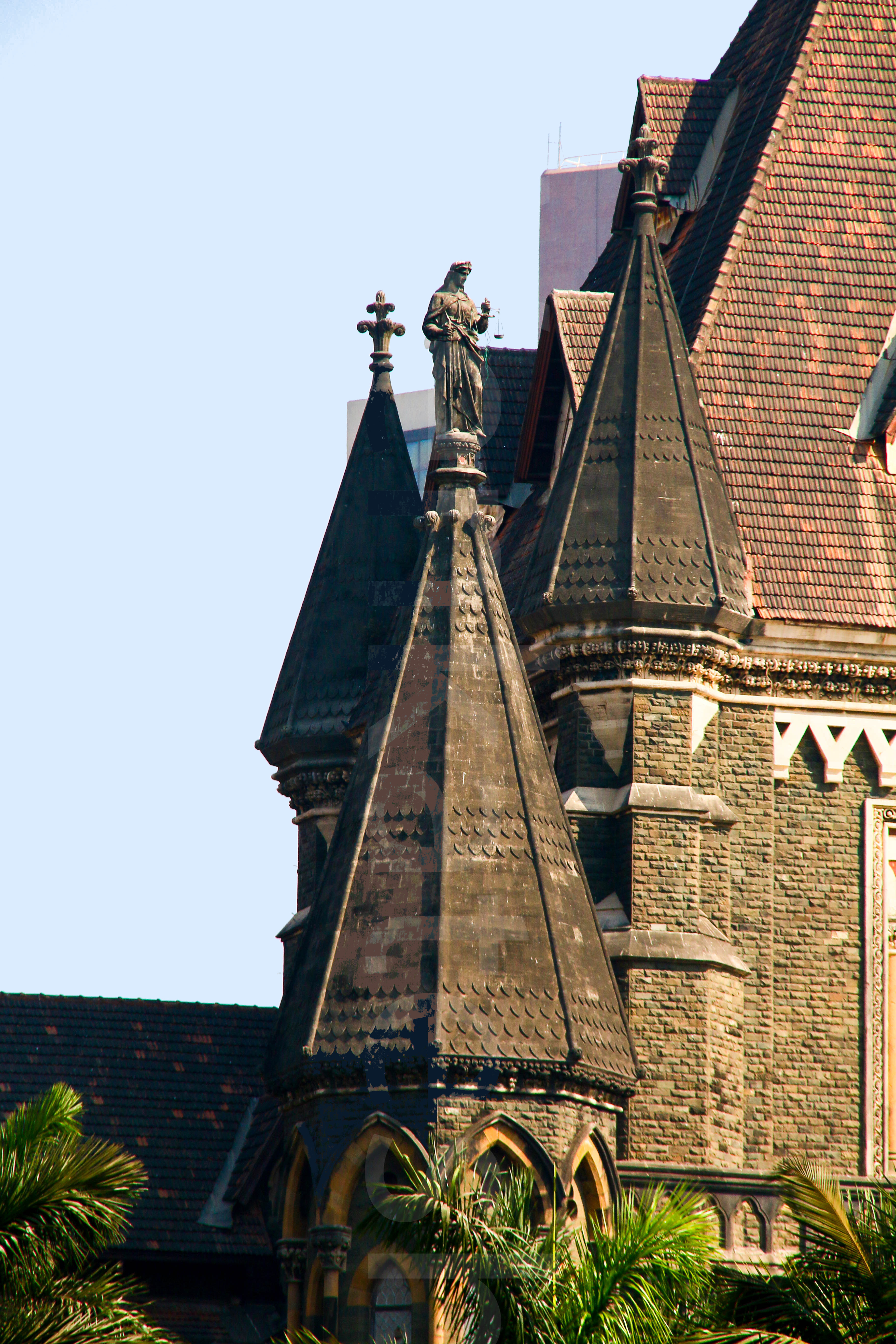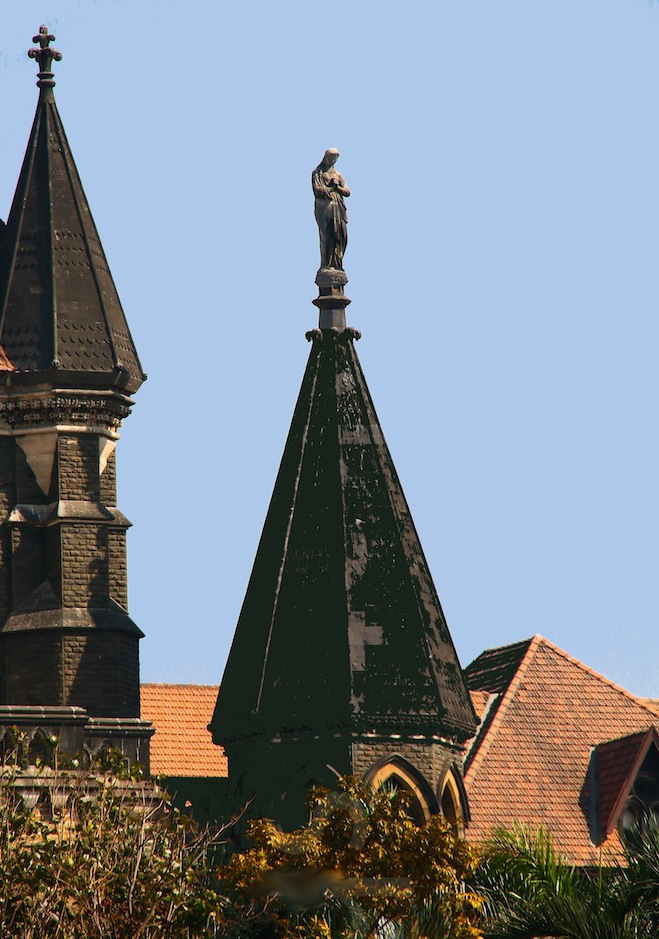The author has kindly contributed all the photographs here, and the main part of the commentary. Readers may wish to see the original version on his own "Heritage Traveller" website, and explore that website further. Please note that he retains copyright of the photographs. A little explanatory material, a few citations, and a brief bibliography have been added by Jacqueline Banerjee during the reformatting.

High Court, Bombay (Mumbai), designed by Colonel (later General) James Augustus Fuller (1823-1902) of the Royal Engineers. Built between 1871-78 at a cost of Rs.1.65 million, the High Court is the second largest public building in Mumbai, after the CST (the former Victoria Terminus). Its eaves stand a lofty 90 feet, the length of the building being 562 feet, breadth 187 feet (see Mehrotra and Dwivedi 42; Davies 160). It stands a great 6 storeys tall, with arcaded galleries that provide both easy movement across the building, and ventilation by being open to the sea on the west.



Left to right: (a) The statue of Justice, with her scales, on top of her pinnacle. (b) The central tower. (c) The statue of Mercy with her scales on top of the other pinnacle. [Click on all the images to enlarge them.]
In designing the mammoth structure, Fuller is said to have been inspired by a German castle. His design also drew from an earlier design by the architect James Trubshawe, with W. Paris and G. T. Molecey, who were assistant architects on the Ramparts Removal Committee, providing the working drawings (see Mehrotra and Dwivedi 36-37). Seen from a few hundred feet away, its dark stone high walls, its arched galleries, its turrets, the massive central tower that is topped by a massive steeply sloped roof, do almost exude an eerie feeling of a haunted European castle. Inside, its grand central stairway, its vaulted arched corridors, and the Minton tiling leave one in awe of its grandeur. There are many subsidiary staircases and they connect the various levels in a very efficient utilitarian manner, the aesthetic elements being the conical roofs visible from a distance. The octagonal towers in the front façade, with pinnacles in Porbunder stone, have the statues of Mercy and Justice as shown above.
Since a close view of the frontal façade from inside the building premises is not permitted unless specially authorized to enter from the Judges' entrance, I have not been able to see the intensive array of sculptures on pillars and cornice bands that it is famous for; there are crocodiles, boars, snakes, monkeys, foxes, lions, storks, owls, eagles, Gremlins and grotesques etc. Authoritative books also cite a half-blindfolded monkey with a balance in its hands, surrounded by foxes and wolves wearing lawyer bands (see Mehrotra and Dwivedi 59; Tindall 190), but I have not seen it yet.
It has several courtrooms, and the central court room is absolutely grand, and I was left in a sense of awe with the height of its roof (the central sloping roof tops this chamber). The furnishing is almost as it was set up in its initial days, and the jury benches are still in place as a vestige of the jury process. The sense of awe peaks as one stands in the central room, humbled by the grand palace in stone. It is said that the third floor has a library with a spacious Venetian balcony, facing the west. It is not accessible to the public.
An eastern extension to the building was made in 1909 to cater to increasing demand for space; but since the court is still functional in a full-fledged manner, there are obvious space crunches that may necessitate the movement of a part of the institution to newer buildings in future.
Historical Context
It is important to understand the historical context of the setup of the High Court. The new juridical system was, after all one of the greatest achievements of the Empire, and the establishment of the High Courts of Bombay, Calcutta and Madras were no casual architectural flamboyance (see also Morris 111-14). They represent an era where active, direct governance of the Empire was just over a decade old, and the first major transformation in the governing institutions was the establishment of the Indian Penal Code. The IPC has to be seen in its context of being a significant improvement from the early centuries of the Raj, and to set right an anachronism that pervaded the judicial system for over a few centuries. The Indian society had for a long time been under diverse application of law. While kings of the princely states had their own ways to dispense justice and there was no standard rule of awarding of punishments for the same crime, the official paramount Mughal court too did not apply the Islamic law in all criminal matters. Hence a lot was left to situational leadership of the authorities dispensing justice. The early British instituted courts in the country had a staffing of legal interpreters of both the Hindu law and the Muslim law, but to bring conformity and a real sense of justice, the standardisation of the process of trial and conviction, supported by codified set of punishments had to be standardised for specific crimes. The mode of trial, including specific rules to be interpreted and applied, and the possibility of the accused getting a chance of fair trial by engaging a lawyer, and the use of evidences, witnesses etc. all were put into place formally in the Victorian age. While the earlier courts established by the East India Company did do some groundwork, their immediate need was to provide some justice mechanism to their own people, not really a governing mechanism for the entire populace. The establishment of the High Court is thus a critical development of the country’s governance itself. The common IPC applied same yardstick of trial process and awarded judgements across all communities and faiths, including Europeans. The independence of the judiciary was reiterated by the eloquent grandeur of the architecture of the High Courts.
Bibliography
Chopra. Preeti. A Joint Enterprise: Indian Elites and the Making of British Bombay. Minneapolis and London: University of Misnnesota Press, 2011.
Davies, Philip. Penguin Guide to Monuments of India 2: Islamic, Rajput, European. London: Viking, 1989.
_____. Splendours of the Raj: British Architecture in India, 1660-1947:. London: Penguin, 1987.
Mehrotra, Rahul, and Sharada Dwivedi. The Bombay High Court — The Story of the Building, 1878-2003. Mumbai: Eminenece Designs, 2004.
Morris, Jan. Stones of Empire: The Buildings of the Raj. Oxford: Oxford University Press, 1983.
Tindall, Gillian. City of Gold: The City of Bombay. New Delhi: Penguin, 1992.
Last modified 1 March 2017